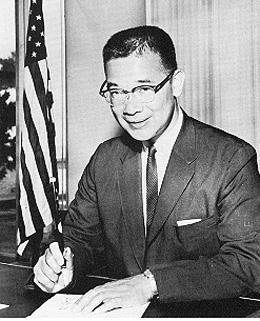On the morning of May 31, 2008, the Wing Luke Asian Museum opens its permanent home in the newly renovated East Kong Yick Building at 719 S King Street. In celebration of the museum's opening, the diverse crowd fills the block in front of the museum. The opening weekend celebration features a ribbon-cutting ceremony, a multicultural drumming performance, and lion and dragon dances. The Wing Luke also offers free admission for its opening weekend.
Honoring Wing Luke
The Wing Luke Asian Museum was founded in 1966 and was named after Wing Luke (1925-1965), the first Asian American to hold public office in the Pacific Northwest. Wing Luke won a seat on the Seattle City Council in 1962, but died in a plane crash in 1965. Luke's supporters contributed money to search for the wreckage of the small plane, and after the plane was found in the Cascade Mountains in 1968, the leftover funds were used to create the museum in his honor.
The museum explores the culture, art, and history of the pan-Asian Pacific American experience and prides itself on its prominent role in the community. In the early 1990s executive director Ron Chew asked Seattle's Japanese community to create its own exhibit on Japanese internment during World War II. Since then, the Wing Luke has depended on the surrounding International District to shape the vision and content of the museum, essentially using the community as its curator.
The East Kong Yick Building
Until 2008, the Wing Luke Museum rented a cramped, 7,500-square-foot garage on 7th Avenue. In the late 1990s, Chew began planning to move the museum to a larger, permanent home. The museum raised $23.2 million from a capital campaign that ended in 2007, relying mostly on small private donations from within the community. The Wing Luke Museum planned to rehabilitate the 1910 East Kong Yick Building, which originally served as a hotel for Chinese immigrants. The historic East Kong Yick Building had been largely abandoned since the 1970s, as the building required a major remodel in order to legally house tenants upstairs.
The architecture firm Olson Sundberg Kundig Allen transformed the East Kong Yick Building from a vacant hotel into a 60,000-square-foot museum. Architect Rick Sundberg salvaged much of the hotel's wood for the exposed beams featured throughout the building as well as the grand open staircase that contains the engraved names of museum donors. Museum donors are also recognized on stacks of rice bowls and on hand-held metal fans used to fan the wind-chime chandelier that graces the entrance of the museum.
History, Art, and Community
The new museum features two "lightwells," long, quiet corridors with skylight ceilings, as well as ample gallery space for exhibits honoring the immigrant journey, Asian American artists, and various Asian immigrant communities. The new museum's first special exhibit opens in October and will feature the native Hawaiian community in the Northwest. The art gallery opened with an exhibition on the sculpture and fountains of George Tsutakawa (1910-1997). In addition to gallery space, the architects also preserved several boardinghouse rooms, a diner, and a large meeting room from the 1910 hotel. The Wing Luke Museum presents these untouched rooms as part of its "Historic Immersion Tours," along with the transplanted Yick Fung Co., a former International District grocery store. The museum moved everything from the closed, import-export store originally a block away into its new space, including the jars of imported food that still adorned the shelves.
For the community, the new Wing Luke Museum offers a library, a children's room, a 59-seat theater, and a large hall with a multimedia system and catering kitchen. The museum theater houses a 100-year-old theatrical curtain that advertises various Japanese businesses. The curtain was originally used by at the Nippon Kan, a nearby Japanese theater. The blending of history, art, and community fulfills the vision of the Wing Luke Museum: to serve its community and to celebrate and support its past, present, and future.

